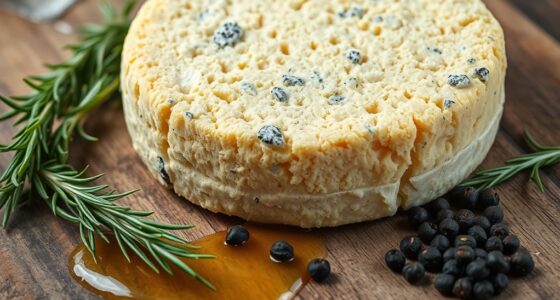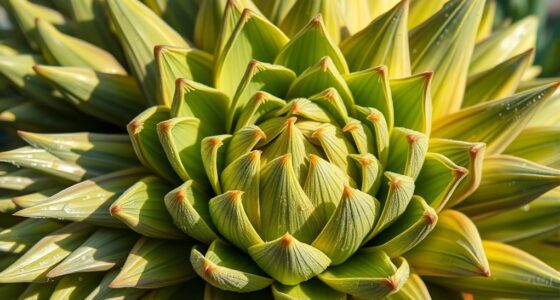Sardinian olive oil is celebrated for its high quality, rich tradition, and unique regional flavors. The production starts with a careful harvest from resilient cultivars like Bosana, Semidana, and Tonda di Cagliari, often using sustainable and traditional methods. Modern techniques, combined with strict quality standards and PDO certifications, guarantee authentic, flavorful oils. Environmental factors like climate and soil influence the aroma, while cultural practices preserve its reputation. Exploring further reveals how Sardinian oil continues to thrive through innovation and tradition.
Key Takeaways
- Sardinian olive oil is produced mainly from native cultivars like Bosana, Tonda di Cagliari, and Semidana, known for unique flavors and high quality.
- The region emphasizes traditional cold pressing methods at controlled temperatures to preserve phenolic compounds and ensure high-quality extra virgin oil.
- PDO “Sardegna” certification guarantees regional authenticity, with strict standards for biochemical profiles, sensory quality, and origin verification.
- Sustainable practices, including eco-friendly harvesting and mechanization, support environmental integrity and consistent oil excellence.
- The flavor profile features fruity, herbaceous, and aromatic notes, reflecting the region’s climate, cultivars, and artisanal processing techniques.
Sardinian Olive Harvesting and Production Timeline
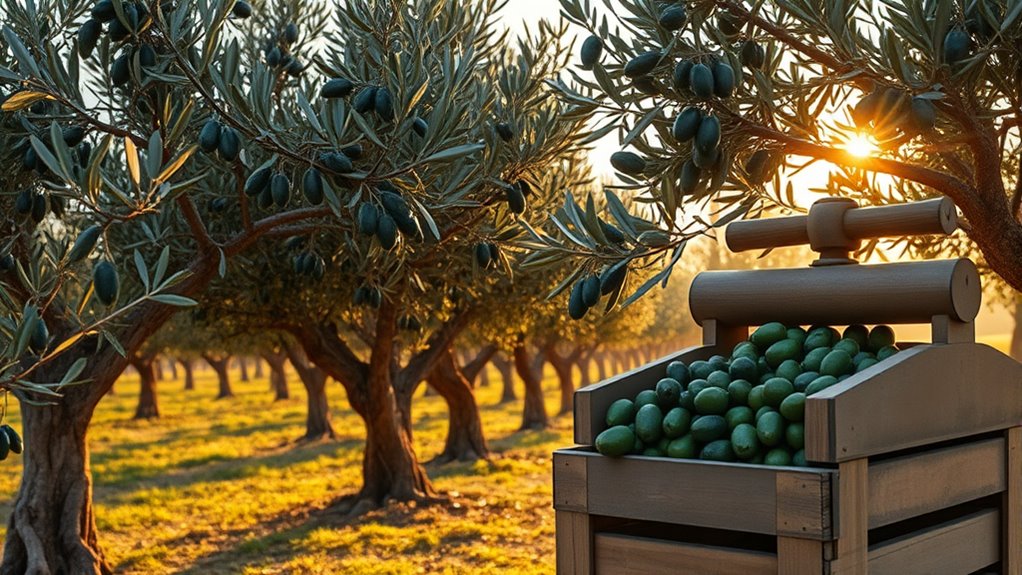
In Sardinia, the olive harvest typically begins in early October, coinciding with the veraison stage when olives start turning from green to black. You’ll find harvests usually extend through November, sometimes into February, depending on climate conditions. Farmers aim to pick early after veraison to preserve oil quality, balancing quantity and flavor. Timing shifts yearly due to drought or weather, which can reduce yields considerably. Traditional practices involve hand-picking or raking olives onto nets to prevent damage. Once harvested, olives are quickly transported to mills for processing within 48 hours, ideally the same day. Cold pressing immediately after cleaning preserves phenolic compounds, ensuring high-quality extra virgin olive oil. The harvest period is also influenced by regional climate patterns and environmental stress, which can lead to variations in the timing and quality of the oil produced. Variations in weather and environmental stress influence both harvest timing and overall production, especially in regions like Parteolla.
Key Olive Cultivars and Their Characteristics

Sardinian olive cultivars each bring unique flavors and qualities to the table. Bosana offers versatility and organic resilience, thriving in tough conditions, while Semidana stands out with its distinctive thistle-like notes and reliable yield. Tonda di Cagliari delivers a fruity, velvety oil that appeals to those seeking a mild, balanced profile. Implementing vertical storage solutions can help preserve these distinct varieties and their flavors more effectively.
Bosana: Versatile and Organic
Bosana stands out as the most prevalent olive cultivar in Sardinia, making up over half of the island’s olive production. Its roots trace back to Spain, but it’s closely linked to the Bosa region, influencing its name. You’ll find Bosana mainly in northern and central Sardinia, like Sassari and Nurra, with some presence in the south, such as Medio Campidano. It’s a hardy variety, thriving in poor soils and windy conditions, even outside Sardinia, like Montenegro. The small to medium-sized olives ripen late and unevenly, turning dark purple or black. Bosana trees have a spreading growth habit, and their fruit yields about 18% oil, renowned for its low acidity and bold flavor. Its oil offers fruity, grassy, almond, and herbal notes, making it a versatile choice for both oil and table use. Additionally, Bosana’s adaptability to less hospitable environments ensures consistent production, supporting both local consumption and export markets. This resilience is further supported by its hardiness in poor soils, which allows it to thrive in challenging conditions and contributes to the sustainability of Sardinian olive cultivation.
Semidana: Unique Thistle Notes
Semidana stands out among Sardinian olive cultivars for its distinctive thistle-like and artichoke nuances, which add a unique character to its oil. These subtle, vegetal notes reflect the cultivar’s Mediterranean terroir and set it apart from other oils. The Mediterranean terroir also influences the oil’s complex flavor profile and aromatic qualities. The oil also features a medium fruity aroma with hints of almond and apple, balancing approachability with complexity. Its flavor profile is marked by a moderate bitterness and spiciness, making it versatile for blending. Semidana’s chemical composition includes high levels of hydroxy-tyrosol, enhancing its antioxidant properties and health benefits. Its reliable yields and adaptability to Sardinia’s organic soils support consistent quality. Overall, Semidana’s unique notes and chemical richness make it a key contributor to Sardinian PDO oils, emphasizing both tradition and nutritional value. Semidana’s cultivation is well-suited to Sardinia’s climate and soil conditions, ensuring stable production and quality.
Tonda Di Cagliari: Fruity and Velvety
Grown mainly in southern Sardinia’s Medio Campidano area, Tonda di Cagliari is a key cultivar known for producing robust, fruity, and velvety extra virgin olive oil. Its large, ovoid fruits with smooth surfaces and prominent lenticels are harvested in mid to late November, guaranteeing ideal ripeness. The oil offers a well-balanced profile, combining a strong presence of bitterness and spiciness with lingering flavors of fresh fruit and cooked vegetables. This versatility makes it perfect for enhancing Sardinian dishes like fregula with mushrooms and herbs. Its semi-mechanical harvesting preserves quality, while cold extraction maintains its organoleptic qualities. Tonda di Cagliari’s unique blend of aromatic richness and smooth texture makes it a prized ingredient in both traditional and modern cuisine. The cultivar is extensively cultivated in the Gonnos area, which contributes to its distinctive flavor profile.
Additionally, proper harvesting techniques are essential to ensure the best possible oil quality, preserving its vibrant aroma and taste.
- Large, symmetrical olives with a rounded apex
- Intense yet balanced flavor profile
- Suitable for raw and cooked dishes
- Harvested carefully to guarantee high quality
Traditional vs. Modern Techniques in Olive Oil Making
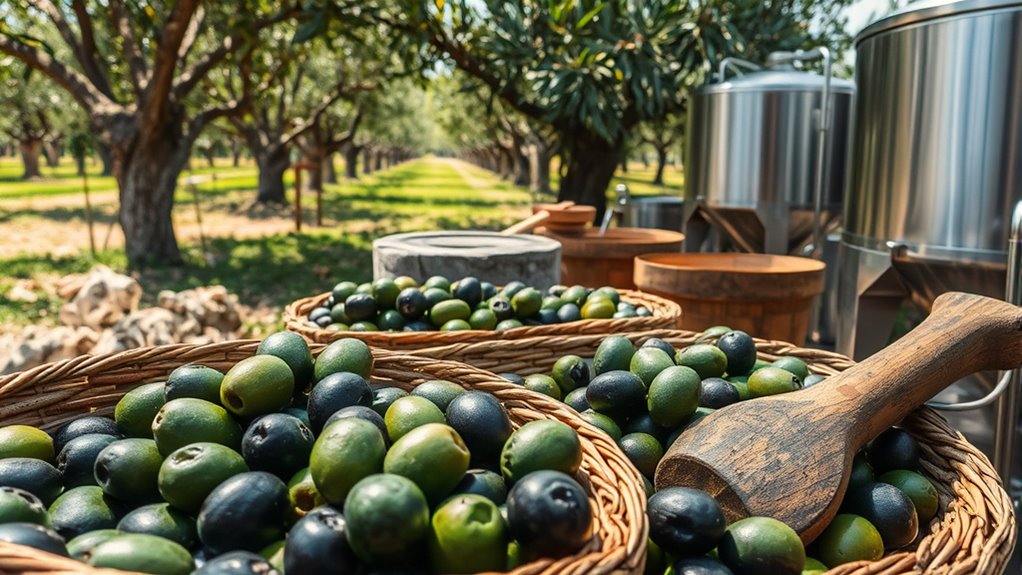
You can see how traditional harvesting and processing methods in Sardinia focus on maintaining flavor and quality through manual techniques, while modern practices emphasize efficiency and higher yields. These differences impact the final oil’s authenticity, chemical composition, and sensory profile. Understanding the balance between tradition and innovation helps guarantee you get genuine Sardinian extra virgin olive oil. Olive varieties cultivated in Sardinia also influence the unique characteristics of the oil, making it distinct from other regions. Additionally, production methods play a crucial role in preserving the oil’s traditional qualities and ensuring its authenticity in the marketplace.
Harvesting Methods Evolution
The evolution from traditional hand-harvesting to modern mechanical techniques has substantially transformed Sardinian olive oil production. You now see shifts toward efficiency, but also changes in quality and tradition.
- Mechanical shakers vibrate trees at high frequencies to quickly dislodge olives, reducing harvest time.
- Automated collection methods, like suction devices, streamline gathering and transport.
- Mechanical harvesting can cause bruising, risking oil flavor and shelf life, unlike gentle manual picking.
- Debris removal at the mill helps maintain oil purity, though increased debris from machinery requires filtering.
- Mechanical harvesting is often used on younger, flat, and uniform trees, which are easier to manage with machines, but it can be less suitable for older, irregular, or steep-slope trees.
- Additionally, some producers are exploring sustainable harvesting practices to preserve both quality and environmental integrity while adopting modern methods.
While mechanization boosts productivity and suits large, flat groves, it can threaten the artisanal quality Sardinian producers value. Balancing efficiency with tradition remains vital.
Processing and Extraction Techniques
Traditional olive oil extraction in Sardinia relies on stone mills and hydraulic presses, methods passed down through generations that emphasize gentle processing to preserve flavor and aroma. Olives are crushed using large granite millstones or multiple stone wheels, breaking cell walls naturally and producing a semi-fluid “oil paste.” Hydraulic presses then apply pressures up to 4,000 kPa to extract oil efficiently. Historically, alternative methods like hammermills and fiber disks made of hemp or coconut were used, pressed hydraulically to separate oil from vegetation water. Modern techniques have shifted toward steel drum mills for more uniform paste preparation and high-speed centrifugation to quickly separate oil, water, and solids. These advancements improve efficiency, hygiene, and control, ensuring higher quality while preserving the traditional emphasis on gentle handling and flavor retention. It is important to note that these modern methods also help reduce processing time, which is crucial for maintaining the freshness and quality of the oil. Incorporating advanced extraction technologies further enhances the preservation of delicate flavors and bioactive compounds in the final product.
Certification and Authenticity Standards
Certification and authenticity standards in Sardinian olive oil guarantee consumers receive genuine, high-quality products. The PDO “Sardegna” label ensures oil is made from at least 80% olives of local varieties like Bosana, Tonda di Cagliari, Tonda di Villacidro, and Semidana. Biochemical profiles verify PDO identity, while strict origin controls maintain regional integrity. Traditional quality evaluation involves sensory panels that detect defects like rancidity or mustiness, ensuring flavor and aroma authenticity. Modern practices enhance transparency through full traceability, digital tracking, and legal compliance, safeguarding against contamination. They also use advanced equipment to prevent oxidation and preserve purity. Both methods work together, combining sensory expertise with scientific safeguards to guarantee high standards and genuine Sardinian olive oil. Traceability systems also help verify the authenticity of the product throughout the entire supply chain.
Quality Standards and Certification Labels
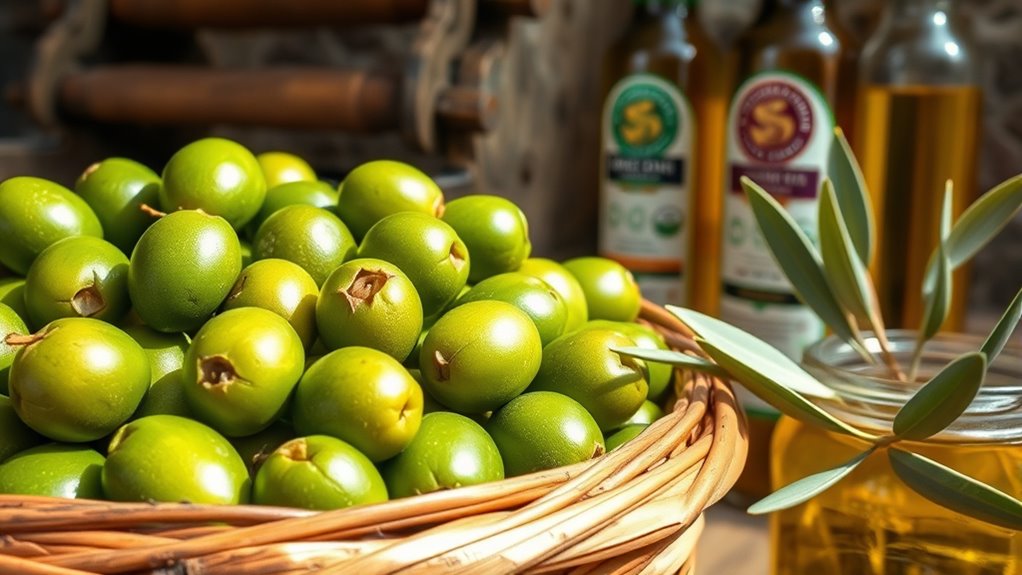
Understanding quality standards and certification labels helps you identify authentic Sardinian olive oil of exceptional quality. PDO (Protected Designation of Origin) and PGI (Protected Geographical Indication) labels are key indicators. PDO guarantees the oil is grown, produced, and bottled within a specific region, following strict rules on varietals and methods, ensuring authenticity. PGI covers broader areas with fewer restrictions but still links the oil to its origin. Both labels display official logos, helping you verify genuine products. Additionally, Italian extra virgin olive oils must pass sensory tests by certified experts, ensuring balanced, fresh flavors without defects. International standards from the IOC set chemical and authenticity benchmarks. Regional consortiums further enforce rigorous controls, maintaining transparency and quality throughout the supply chain. Cookies and privacy policies also play a role in ensuring transparency and trust in product origin and quality standards.
Unique Flavors and Sensory Profiles of Sardinian Oils

Sardinian olive oils are renowned for their distinctive sensory profiles, showcasing a range of vibrant and complex flavors. You’ll notice fruity notes that evoke fresh, ripe olives, especially in early harvest oils like ‘il Novello’. Some oils, like DOP Sardegna Corax, offer herbaceous flavors with hints of artichoke and thistle. You’ll also experience a balance of bitter and spicy notes, adding depth to the taste. Aromatic qualities such as grass, tomato leaf, and herbs are common, enriching the overall experience.
Sardinian olive oils feature fruity, herbaceous, and aromatic flavors with a perfect balance of bitterness and spiciness.
- Fruity, fresh flavors from high-quality oils
- Herbaceous hints of artichoke and thistle
- Complex bitter and spicy balance
- Aromas of grass, herbs, and tomato leaf
Environmental Factors Influencing Olive Growth and Oil Quality
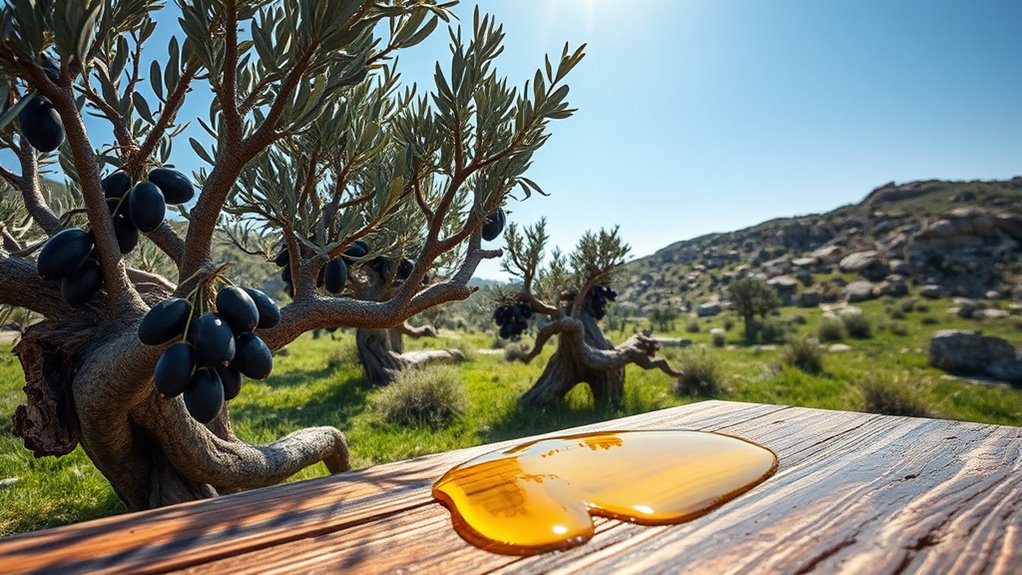
Environmental factors such as climate, soil, and light exposure play a essential role in shaping the growth and quality of olive oils. Mediterranean climates with mild, wet winters and hot, dry summers create ideal conditions for olive cultivation, especially when temperatures stay between 15–20 °C. Cooler temperatures below 7 °C are necessary for flowering, but frost below −7 °C can damage trees. High altitudes over 800 meters hinder growth due to shorter seasons and frost risk. Soil type matters too; olive trees thrive in calcareous, rocky soils with good drainage, which support healthy roots and nutrient uptake. Adequate sunlight boosts photosynthesis and phenolic compounds, enhancing oil quality. Climate variability impacts flowering, yield, and oil composition, making environmental resilience crucial for Sardinian olive growers. Additionally, climatic stability ensures consistent production and high-quality oil over successive seasons.
Sardinia’s Cultural Significance and Health Benefits of Olive Oil

Olive oil has deep roots in Sardinian culture, shaping traditions and community life for thousands of years. It’s more than a cooking ingredient—it’s part of rituals, social bonds, and regional identity. You’ll find ancient olive trees and artifacts that show how deeply intertwined olive cultivation is with Sardinia’s history. During Spanish rule, production expanded, turning olive oil into a key economic driver. Sardinian native cultivars, some over 2,000 years old, produce oils with unique flavors reflecting the island’s terroir. Archaeological finds indicate that olive oil was used in Sardinia long before many other regions, highlighting its longstanding significance. – Cultural symbols representing resilience and land connection – Traditional practices preserving high-quality extraction methods – Health benefits like cardiovascular support and antioxidants – Longevity link contributing to Sardinia’s reputation as a Blue Zone
Future Trends and Developments in Sardinian Olive Oil Production

Advancements in technology are transforming Sardinian olive oil production, making processes more efficient and ensuring higher quality. Ultrasound technology, tested at San Giuliano in 2023, improves extraction efficiency and boosts yields. Olive pressing is now optimized within 12 hours of harvest to preserve fruit integrity and maximize oil quality. During extraction, processing temperatures are strictly kept at 77°F to maintain phenolic content and flavor. Traceability systems are implemented across production lines, enhancing quality assurance and consumer confidence. Investment in modern milling facilities supports organic and premium extra virgin olive oils. Land use is expanding, with plans to increase olive groves to around 1,000 hectares over ten years, utilizing sustainable practices like converting neglected lands and planting drought-resistant cultivars. Climate change impacts are prompting producers to adopt more resilient practices to ensure consistent quality and supply. These innovations position Sardinian olive oil for a resilient, high-quality future.
Frequently Asked Questions
How Does Sardinian Olive Oil Compare to Other Italian Regional Oils in Flavor?
When comparing Sardinian olive oil to other Italian regional oils, you’ll notice it has a more pronounced herbaceous, bitter, and spicy flavor. Unlike Tuscany’s fruity and grassy notes or Puglia’s milder profile, Sardinian oil offers a bold, fresh taste with intense artichoke and thistle tones. Its unique use of Bosana olives and traditional methods give it a sharper, more complex character that stands out in Mediterranean dishes.
What Specific Harvesting Methods Ensure the Best Quality Sardinian Olive Oil?
You want the best quality Sardinian olive oil, so focus on traditional harvesting methods like hand-picking and tree combing. These gentle techniques prevent damage and preserve olive integrity, ensuring superior flavor and aroma. Harvest at the right ripeness—usually from mid-October to January—to optimize oil characteristics. Promptly transport and mill the olives within 12 hours, using cold extraction to maintain freshness and prevent oxidation, resulting in premium, flavorful oil.
Are There Sustainable or Organic Certifications Unique to Sardinian Olive Oils?
You ask if Sardinian olive oils have unique sustainable or organic certifications. While Sardinia adheres to EU organic standards and can earn international certifications like ISO 9001:2015, there’s no certification exclusive to the region. Producers often combine these standards with PDO “Sardegna” to ensure quality and origin. Sustainability is emphasized through traditional farming practices, but no Sardinian-specific eco-label currently exists beyond these broader certifications.
How Do Climate Changes Impact Future Olive Oil Production in Sardinia?
Climate changes threaten your future olive oil production by causing droughts, heatwaves, and wildfires that damage olive groves and reduce yields. Higher temperatures and irregular rainfall lower fruit quality and quantity, while pests and diseases become more prevalent. You’ll face increased operational risks and higher costs, making it essential to adopt resilient practices like drought-resistant cultivars and improved water management to safeguard your harvest and maintain quality.
What Are Consumer Preferences for Sardinian Olive Oil in International Markets?
You’ll find that international consumers prefer Sardinian olive oil for its distinct herbal and artichoke flavors, reflecting its authentic regional character. They value its high quality, often influenced by awards and traditional production methods, and show a strong preference for Italian origin labels. Organic options and flavored varieties like lemon or chili also attract attention, especially when marketed through online platforms and culinary promotions that emphasize its heritage and premium status.
Conclusion
Discovering Sardinian olive oil is like opening a treasure chest of unrivaled flavors and rich traditions. With its unique cultivars, meticulous craftsmanship, and pristine environment, each drop embodies centuries of passion and perfection. As you savor its vibrant aroma and complex profiles, remember you’re tasting a liquid masterpiece that could easily be mistaken for liquid gold. Embrace the legacy and future of Sardinian olive oil—your palate will thank you for this extraordinary journey.


